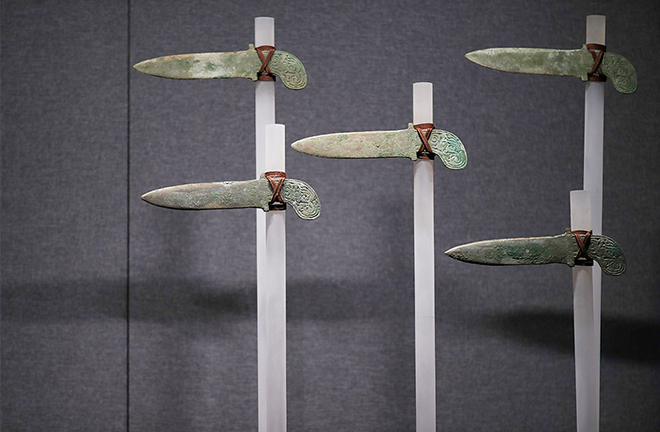Archaeologists reveal uninterrupted Chinese civilization

Bronze weapons unearthed at the Erlitou site in Luoyang, Henan Province Photo: CFP
ZHENGZHOU—Scholars shed light on the uninterrupted Chinese civilization which endured for five millennia, the formation of Chinese civilization, and the Chinese nation from the perspective of archaeology, at a seminar in Zhengzhou, Henan Province, on March 12 and 13.
Material carrier
“Civilized society” is not a figment of history, but a real embodiment in the material remains of civilization. Liu Qingzhu, Member of the Chinese Academy of Social Sciences and dean of the School of History at Zhengzhou University, views capital cities, mausoleums, writing, and ritual vessels, which are closely related to “national culture,” as the “materialized carrier” of civilization.
In the development history of Chinese civilization, ancient capitals and cities, as well as mausoleums’ planning, shape, and institutional evolution, show the historical characteristics of continuity. Zheng Junlei, a professor from the School of Sociology and Anthropology at Sun Yat-sen University, found historical continuity when examining the pre-Qin (prior to 221 BCE) vassal states and the Qin (221–207 BCE) and Han (206 BCE–220 CE) prefectures and counties, with similar spatial structures and territorial scope. The system of prefectures and counties during the Qin and Han era was developed upon Eastern Zhou Dynasty (770–221 BCE) prefectures and counties, forming an obvious succession relationship.
According to Liu Yi, a professor from the Faculty of History at Nankai University, mausoleum archaeology has enriched historical connotations, supplemented and corrected historical facts, and truly reflected the system of rites and music, royal and imperial funerary customs, and corresponding beliefs and ancient concepts. Burial objects in imperial mausoleums represent the highest craft level of the day, and imperial and royal mausoleum buildings represent the highest construction techniques of the time. The development and evolution of the ancient Chinese mausoleum system epitomizes the formation of a unified multi-ethnic country.
Based on the study of the construction and function of metallurgical systems, Liu Haiwang, president of Henan Provincial Institute of Cultural Heritage and Archaeology, noted that the discovery, mining, smelting, manufacturing, and use of metals are a critical material basis and significant symbol of social civilization, going from emergence and development to prosperity. During its initial formation, the Chinese civilization built a unique metallurgical system centered around copper and iron, which became a symbol and support for the initial formation of the pluralistic integration of Chinese civilization. The site of a copper casting workshop was found at an Erlitou site (c. 1800–1500 BCE). China’s Bronze Age was from the Xia Dynasty (c. 21th–16th century BCE) represented by the Erlitou culture to the early and middle Warring States Period (475–221 BCE). The high development of bronze smelting technology during the Shang (c. 16th–11th century BCE) and Zhou (c. 11th century–221 BCE) dynasties established the historical status of ancient Chinese civilization in the world.
Ethnic integration
Huo Wei, a professor from the School of History and Culture at Sichuan University, explained with massive archaeological results that since the Shang and Zhou dynasties, Chinese civilization transitioned from an early period to a unified Qin and Han empire. The Spring and Autumn Period (770–476 BCE) and the Warring States Period saw a reorganization of the community of ethnic minorities and the Huaxia people [ancestors of the Han people]. After the unification in the Qin and Han dynasties, there appeared several waves of great upheavals and great fusions between the south and the north, which reflected the identity of the Central Plain culture against a multicultural backdrop. After the unification in the Qin and Han dynasties, the cultural gene of the Chinese nation grew constantly and stood out among world civilizations, although there were sometimes divisions and sometimes unity.
The formation of the Chinese civilization can be traced back to the Neolithic Age. The achievements of different regions have integrated into the Chinese civilization. The Central Plain [in the middle and lower reaches of the Yellow River] and the Jianghan Plain [in the middle reaches of the Yangtze River] are the two core regions of the origin and development of Chinese civilization, sharing a long history of interaction and exchange.
According to Jin Song’an, a professor from the School of History at Zhengzhou University, in the late Longshan era (c. 4000 BP), the large-scale southward expansion of the Wangwan III culture completely reversed the cultural interaction situation between the Central Plain and Jianghan Plain, changed the social development process of the Shijiahe culture, and also laid a foundation for the rise of the Erlitou culture.
Guo Weimin, a professor from the Yuelu Academy at Hunan University, proposed that the two civilized regions of the Central Plain and the middle reaches of the Yangtze River communicated at different times in the Neolithic Age. Around 10,000 years ago, the northern and southern cultures met in the Central Plain. About 5,000 years ago, the Qujialing culture in the middle reaches of the Yangtze River had a significant influence in the Central Plain and merged into the Huaxia culture.
The era between the Han and Tang (618–907) dynasties was a vital historical stage for the fusion of northern and southern ethnicities, as well as a key period for the integration of Chinese civilization, said Li Meitian, a professor from the School of History at Renmin University of China.
Edited by YANG LANLAN
